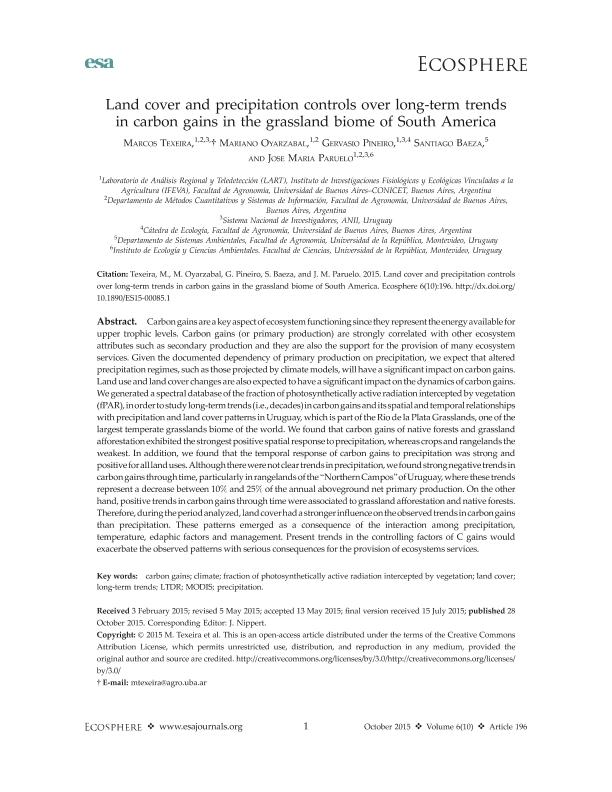Mostrar el registro sencillo del ítem
dc.contributor.author
Texeira González, Marcos Alexis

dc.contributor.author
Oyarzabal, Mariano

dc.contributor.author
Piñeiro, Gervasio

dc.contributor.author
Baeza, Santiago
dc.contributor.author
Paruelo, José

dc.date.available
2017-06-02T21:29:08Z
dc.date.issued
2015-10
dc.identifier.citation
Texeira González, Marcos Alexis; Oyarzabal, Mariano; Piñeiro, Gervasio; Baeza, Santiago; Paruelo, José; Land cover and precipitation controls over long-term trends in carbon gains in the grassland biome of South America; Ecological Society of America; Ecosphere; 6; 10; 10-2015; 1-21; 196
dc.identifier.issn
2150-8925
dc.identifier.uri
http://hdl.handle.net/11336/17448
dc.description.abstract
Carbon gains are a key aspect of ecosystem functioning since they represent the energy available for upper trophic levels. Carbon gains (or primary production) are strongly correlated with other ecosystem attributes such as secondary production and they are also the support for the provision of many ecosystem services. Given the documented dependency of primary production on precipitation, we expect that altered precipitation regimes, such as those projected by climate models, will have a significant impact on carbon gains. Land use and land cover changes are also expected to have a significant impact on the dynamics of carbon gains. We generated a spectral database of the fraction of photosynthetically active radiation intercepted by vegetation (fPAR), in order to study long-term trends (i.e., decades) in carbon gains and its spatial and temporal relationships with precipitation and land cover patterns in Uruguay, which is part of the Rio de la Plata Grasslands, one of the largest temperate grasslands biome of the world. We found that carbon gains of native forests and grassland afforestation exhibited the strongest positive spatial response to precipitation, whereas crops and rangelands the weakest. In addition, we found that the temporal response of carbon gains to precipitation was strong and positive for all land uses. Although there were not clear trends in precipitation, we found strong negative trends in carbon gains through time, particularly in rangelands of the "Northern Campos" of Uruguay, where these trends represent a decrease between 10% and 25% of the annual aboveground net primary production. On the other hand, positive trends in carbon gains through time were associated to grassland afforestation and native forests. Therefore, during the period analyzed, land cover had a stronger influence on the observed trends in carbon gains than precipitation. These patterns emerged as a consequence of the interaction among precipitation, temperature, edaphic factors and management. Present trends in the controlling factors of C gains would exacerbate the observed patterns with serious consequences for the provision of ecosystems services.
dc.format
application/pdf
dc.language.iso
eng
dc.publisher
Ecological Society of America

dc.rights
info:eu-repo/semantics/openAccess
dc.rights.uri
https://creativecommons.org/licenses/by-nc-sa/2.5/ar/
dc.subject
CARBON GAINS
dc.subject
CLIMATE
dc.subject
FRACTION OF PHOTOSYNTHETICALLY ACTIVE RADIATION INTERCEPTED BY VEGETATION
dc.subject
LAND COVER
dc.subject
LONG-TERM TRENDS
dc.subject
LTDR
dc.subject
MODIS
dc.subject
PRECIPITATION
dc.subject.classification
Ecología

dc.subject.classification
Ciencias Biológicas

dc.subject.classification
CIENCIAS NATURALES Y EXACTAS

dc.title
Land cover and precipitation controls over long-term trends in carbon gains in the grassland biome of South America
dc.type
info:eu-repo/semantics/article
dc.type
info:ar-repo/semantics/artículo
dc.type
info:eu-repo/semantics/publishedVersion
dc.date.updated
2017-06-02T17:32:00Z
dc.journal.volume
6
dc.journal.number
10
dc.journal.pagination
1-21; 196
dc.journal.pais
Estados Unidos

dc.journal.ciudad
Hoboken
dc.description.fil
Fil: Texeira González, Marcos Alexis. Consejo Nacional de Investigaciones Científicas y Técnicas. Oficina de Coordinación Administrativa Parque Centenario. Instituto de Investigaciones Fisiológicas y Ecológicas Vinculadas a la Agricultura. Universidad de Buenos Aires. Facultad de Agronomía. Instituto de Investigaciones Fisiológicas y Ecológicas Vinculadas a la Agricultura; Argentina
dc.description.fil
Fil: Oyarzabal, Mariano. Consejo Nacional de Investigaciones Científicas y Técnicas. Oficina de Coordinación Administrativa Parque Centenario. Instituto de Investigaciones Fisiológicas y Ecológicas Vinculadas a la Agricultura. Universidad de Buenos Aires. Facultad de Agronomía. Instituto de Investigaciones Fisiológicas y Ecológicas Vinculadas a la Agricultura; Argentina
dc.description.fil
Fil: Piñeiro, Gervasio. Consejo Nacional de Investigaciones Científicas y Técnicas. Oficina de Coordinación Administrativa Parque Centenario. Instituto de Investigaciones Fisiológicas y Ecológicas Vinculadas a la Agricultura. Universidad de Buenos Aires. Facultad de Agronomía. Instituto de Investigaciones Fisiológicas y Ecológicas Vinculadas a la Agricultura; Argentina
dc.description.fil
Fil: Baeza, Santiago. Universidad de la República; Uruguay
dc.description.fil
Fil: Paruelo, José. Consejo Nacional de Investigaciones Científicas y Técnicas. Oficina de Coordinación Administrativa Parque Centenario. Instituto de Investigaciones Fisiológicas y Ecológicas Vinculadas a la Agricultura. Universidad de Buenos Aires. Facultad de Agronomía. Instituto de Investigaciones Fisiológicas y Ecológicas Vinculadas a la Agricultura; Argentina. Universidad de la República; Uruguay
dc.journal.title
Ecosphere
dc.relation.alternativeid
info:eu-repo/semantics/altIdentifier/doi/http://dx.doi.org/10.1890/ES15-00085.1
dc.relation.alternativeid
info:eu-repo/semantics/altIdentifier/url/http://onlinelibrary.wiley.com/doi/10.1890/ES15-00085.1/abstract
Archivos asociados
